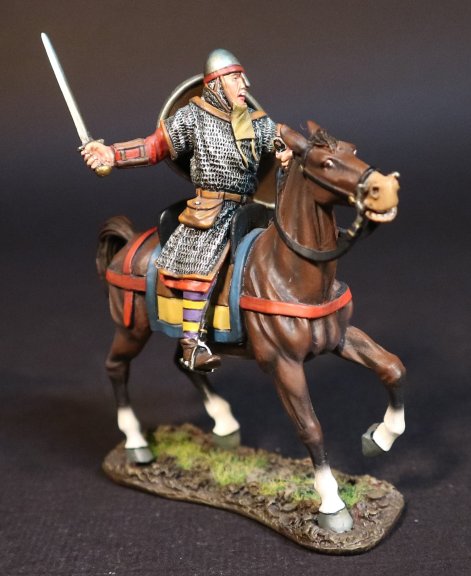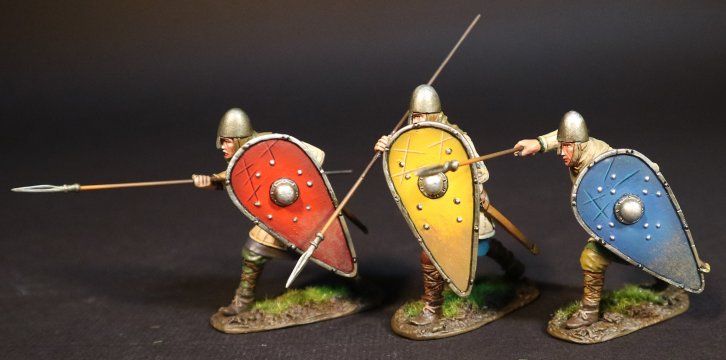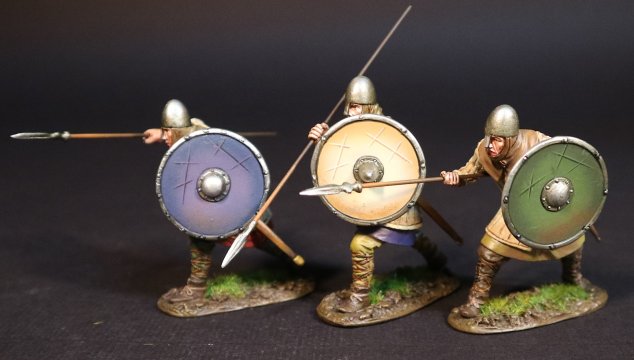- Joined
- Feb 2, 2011
- Messages
- 2,373
NEW RELEASES FOR AUGUST 2024
THE AGE OF ARTHUR
THE BATTLE OF HASTINGS 1066
THE NORMAN ARMY
The Battle of Hastings took place on the 14th October 1066. Although the numbers on each side were about equal, William had the advantage of having both cavalry, infantry and many archers.
Harold had only foot soldiers, and few archers. The English formed a shield wall along a ridge, and were initially so effective that the invading Norman army was repeatedly thrown back with heavy casualties.
ALAN RUFUS
Alan Rufus (c. 1040 -1093) was a Breton nobleman, cousin and companion of William the Conqueror during the Norman conquest of England.
He was the second son of Eozen Penteur, a Count of Brittany, and an older maternal first cousin of Edward King of England.

NM-50
THE AGE OF ARTHUR,
THE NORMAN ARMY,
ALAN RUFUS.
During the Battle of Hastings, there is evidence that Alan Rufus led William’s Household Knights whilst Alan’s brother Breon led the left wing. This put Alan in the perfect position to co-ordinate feints with his brother. Breon would draw the inexperienced Saxon fyrdmen forward, and the other would follow in behind and isolate the pursuing Saxons. This was a modification of tactics used by the Bretons for many years. An example being the Battle of Jengland AD851.
Several documents refer to Gyrth Godwinson, Harold’s younger brother and Earl of East Anglia, leading an assault on William’s position. William’s horse was cut down from under him, Gyrth seeing this moved to kill him, but someone stopped him, and Gyrth was killed instead. Without the experienced leadership of Gyrth at the front of the shield wall, and since Harold’s other younger brother Leofric Earl of Essex had already fallen, this probably proved decisive factor in the English defeat.
William’s chroniclers say he cut down Gyrth, but Domesday evidence tells us that one of William’s Breton allies rode to his rescue, either Ralph “the Staller”, or Alan Rufus.
Alan Rufus, and many of the Breton Knights were to be granted considerable land holdings by William the Conqueror in return for their services.
Rufus would receive land in Northern England and later he would build Richmond Castle. Many of Alan Rufus’s early acquisitions in England included many land titles that had been in the possession of King Harold’s wife Edith the Fair, including all but one of her holdings in Cambridgeshire.
By 1086 Alan had become one of the richest and most powerful men in England.
BRETON INFANTRY
Although there are some references to Breton infantry at Hastings, they seemed to have been depended so exclusively on cavalry that the infantry were known as being very poor. There is very little known during this period of the Bretons fighting on foot, a source around 1120 records Bretons as being seven times better fighting on horse than on foot.

NM-58A
THE AGE OF ARTHUR,
THE NORMAN ARMY,
BRETON INFANTRY.

NM-58B
THE AGE OF ARTHUR,
THE NORMAN ARMY,
BRETON INFANTRY.
** PLEASE CONTACT YOUR LOCAL DEALER FOR FURTHER INFORMATION **
THE AGE OF ARTHUR
THE BATTLE OF HASTINGS 1066
THE NORMAN ARMY
The Battle of Hastings took place on the 14th October 1066. Although the numbers on each side were about equal, William had the advantage of having both cavalry, infantry and many archers.
Harold had only foot soldiers, and few archers. The English formed a shield wall along a ridge, and were initially so effective that the invading Norman army was repeatedly thrown back with heavy casualties.
ALAN RUFUS
Alan Rufus (c. 1040 -1093) was a Breton nobleman, cousin and companion of William the Conqueror during the Norman conquest of England.
He was the second son of Eozen Penteur, a Count of Brittany, and an older maternal first cousin of Edward King of England.

NM-50
THE AGE OF ARTHUR,
THE NORMAN ARMY,
ALAN RUFUS.
During the Battle of Hastings, there is evidence that Alan Rufus led William’s Household Knights whilst Alan’s brother Breon led the left wing. This put Alan in the perfect position to co-ordinate feints with his brother. Breon would draw the inexperienced Saxon fyrdmen forward, and the other would follow in behind and isolate the pursuing Saxons. This was a modification of tactics used by the Bretons for many years. An example being the Battle of Jengland AD851.
Several documents refer to Gyrth Godwinson, Harold’s younger brother and Earl of East Anglia, leading an assault on William’s position. William’s horse was cut down from under him, Gyrth seeing this moved to kill him, but someone stopped him, and Gyrth was killed instead. Without the experienced leadership of Gyrth at the front of the shield wall, and since Harold’s other younger brother Leofric Earl of Essex had already fallen, this probably proved decisive factor in the English defeat.
William’s chroniclers say he cut down Gyrth, but Domesday evidence tells us that one of William’s Breton allies rode to his rescue, either Ralph “the Staller”, or Alan Rufus.
Alan Rufus, and many of the Breton Knights were to be granted considerable land holdings by William the Conqueror in return for their services.
Rufus would receive land in Northern England and later he would build Richmond Castle. Many of Alan Rufus’s early acquisitions in England included many land titles that had been in the possession of King Harold’s wife Edith the Fair, including all but one of her holdings in Cambridgeshire.
By 1086 Alan had become one of the richest and most powerful men in England.
BRETON INFANTRY
Although there are some references to Breton infantry at Hastings, they seemed to have been depended so exclusively on cavalry that the infantry were known as being very poor. There is very little known during this period of the Bretons fighting on foot, a source around 1120 records Bretons as being seven times better fighting on horse than on foot.

NM-58A
THE AGE OF ARTHUR,
THE NORMAN ARMY,
BRETON INFANTRY.

NM-58B
THE AGE OF ARTHUR,
THE NORMAN ARMY,
BRETON INFANTRY.
** PLEASE CONTACT YOUR LOCAL DEALER FOR FURTHER INFORMATION **

